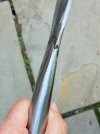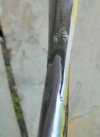- Joined
- Nov 20, 2008
- Messages
- 10,188
I don't know if its the difference in the two metals, or my technique, but I am unable to get a seamless weld joining the socket to the spearhead. The socket is very securely attached, both by weld and pins as you can see, I just don't like the appearance. Should I heat it up and go again, until the metals are truly seamless, or is it a rather lost cause? Any advice would be appreciated.


